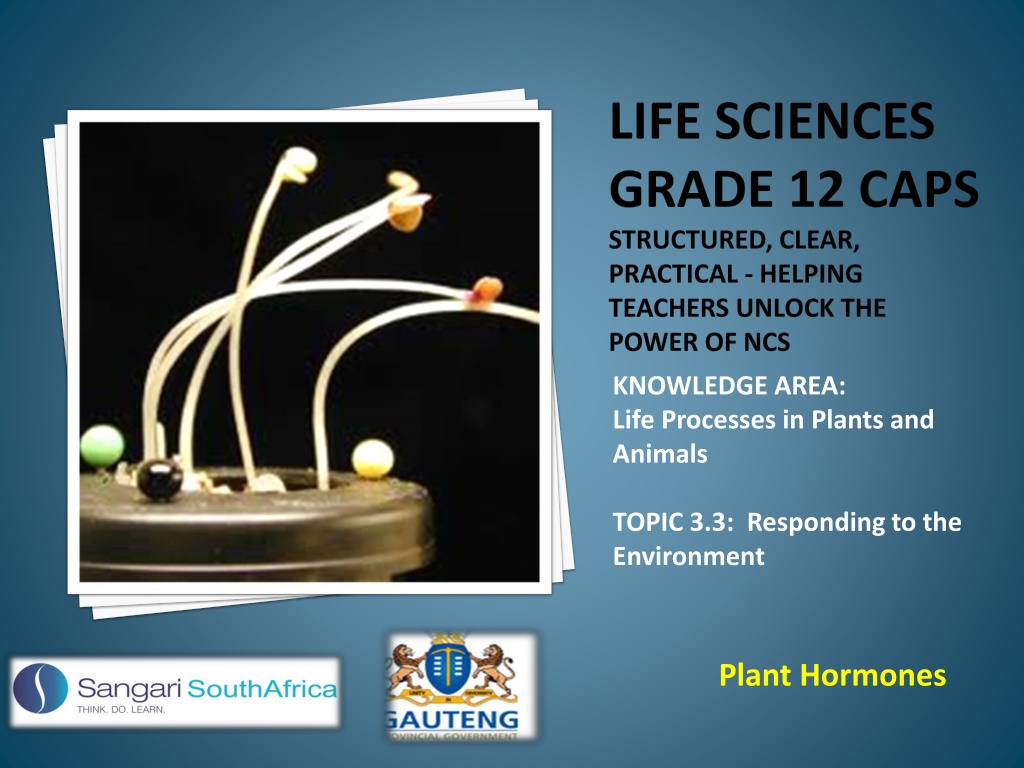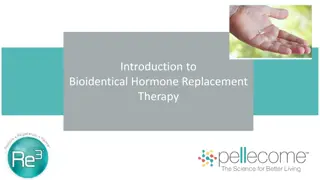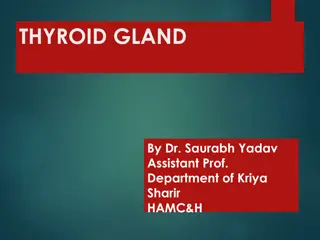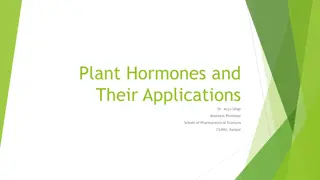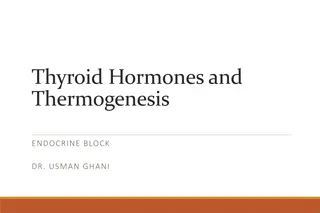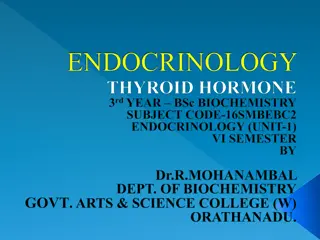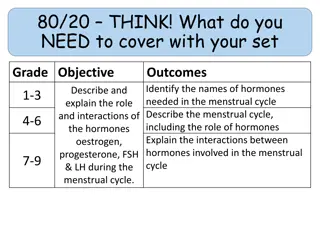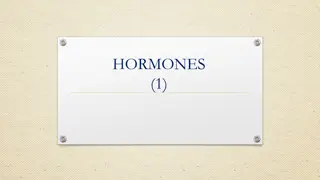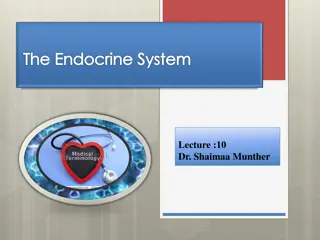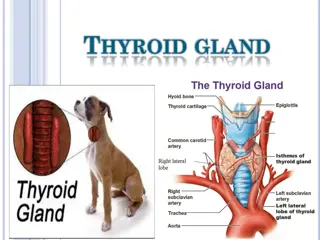Understanding Plant Hormones and Their Functions in Plants
Plant hormones play crucial roles in various plant processes such as growth, development, and response to environmental stimuli. Auxins, gibberellins, and abscisic acid are key plant hormones that regulate tropisms, cell division, elongation, flowering, seed germination, and dormancy. Understanding the functions of plant hormones helps in comprehending how plants respond and adapt to their surroundings.
Download Presentation

Please find below an Image/Link to download the presentation.
The content on the website is provided AS IS for your information and personal use only. It may not be sold, licensed, or shared on other websites without obtaining consent from the author. Download presentation by click this link. If you encounter any issues during the download, it is possible that the publisher has removed the file from their server.
E N D
Presentation Transcript
LIFE SCIENCES GRADE 12 CAPS STRUCTURED, CLEAR, PRACTICAL - HELPING TEACHERS UNLOCK THE POWER OF NCS KNOWLEDGE AREA: Life Processes in Plants and Animals TOPIC 3.3: Responding to the Environment Plant Hormones
SUMMARY OF THE PRESENTATION: Plant Hormones Plant Defense Mechanisms
PLANT HORMONES Some examples of plant hormones are Auxins Gibberellins Abscisic Acid These substances are not true hormones because they work in the part of the plant where they are produced. Therefore they are also referred to as plant growth substances. a) b) c) Lets look at the functions of each of these plant growth substances.
PLANT HORMONES Auxins a) Auxins bring about bending reactions in plants. These bending reactions are called tropisms. Some examples of tropisms are geotropism and phototropism. They promote cell division. They are also responsible for cell elongation. They bring about apical dominance. This means that the auxin found in the apical bud will promote vertical growth and reduce growth of the lateral branches.
PLANT HORMONES When the apical bud is removed then apical dominance is lost. This mean that the lateral branches will grow. The auxins also promote root development. Gibberellins: b) They have the following functions They cause the internodes of the stem to elongate. They stimulate root growth. 1. 2.
PLANT HORMONES They promote the development of flowers. Brings about germination of seeds, this means the gibberellins stimulate the growth of the seed. They also increase fruit size. It is also thought that they promote the sprouting of dormant buds. 3. 4. 5. 6.
TERMINOLOGY: TERM: Tropisms DEFINITION: USE IN SENTENCES: Refers to bending movements in plants that are brought about by a response to a certain external stimuli. The tropsims can be brought about by a response to light or gravity.
PLANT HORMONES Abscisic Acid c) Abscisic acid has the following functions It slows down germination and therefore is able to bring about dormancy of seeds. Its brings about dormancy of apical buds. Responsible for the onset of flowering in some plants. It promotes the aging of leaves. 1. 2. 3. 4.
PLANT HORMONES It helps to close the stomata in times of drought therefore reducing water loss by transpiration. 5.
PLANT HORMONES Controlling Weeds using Plant Hormones: Hormone weed killers are auxin-based selective herbicides. The auxins used in these weed killers are made by chemical synthesis. The main factor that controls the weed growth in these herbicides are the auxins. These herbicides can only kill weeds.
PLANT HORMONES But they must be used in the correct dosage. However the plants that are similar to the weeds can be damaged, but they are not killed. The plants that are similar to the weeds are called broad-leaved plants.
PLANT HORMONES Symptoms of Damage to Broad-leaved plants caused by hormone weed killers Distorted or twisted leaf stalks Swollen stems Warts or galls on plants 1. 2. Damage caused by hormone weed killers 3.
PLANT HORMONES If the weed killer is used in large quantities it can caused reduced plant growth. And can result in death of the plant. Therefore it is important to follow the dosage suggested by the manufacturer.
PLANT HORMONES Advantages of Hormone Weed-killers They are non toxic to animals and humans. There is no longer the need for weeding the garden. 1. 2.
PLANT HORMONES Tropisms: As mentioned earlier tropisms are bending reaction in plants in response to a stimulus. The tropism is brought about by auxins. The direction of the tropism is dependent on the direction of the stimulus. These auxins are found at the tip of roots and shoots. Indole-acetic acid (IAA) is the most well known auxin. We shall look at 2 types of tropisms.
PLANT HORMONES These are geotropism and phototropism. Geotropism is a bending reaction in plants to the stimulus of gravity. Phototropism is a bending reaction in plants in reaction to the stimulus of light. We shall look at the role of auxins in each of these tropisms.
TERMINOLOGY: TERM: Phototropism DEFINITION: USE IN SENTENCE: This is when the plant grows towards the stimulus of light. When stems are phototrophic because they grow towards light.
TERMINOLOGY: TERM: Geotropism DEFINITION: USE IN SENTENCE: Is a bending movement in response to the stimulus of gravity Roots are geotropic because they grow towards gravity.
PLANT HORMONES Role of Auxins in Geotropism: In the root auxins are produced at the tip of the root. If the auxins are evenly distributed around the root then the root grows straight downwards. But If a root is placed horizontally, gravity pulls the auxins to the lower side of the root.
PLANT HORMONES Therefore there is an uneven distribution of auxins. One side has more auxins than the other. In roots a high concentration of auxins inhibits growth. Therefore the upper side with less auxins will grow faster. The upper side will therefore bend downwards. That is towards gravity. Since the roots grows towards gravity we say that it is positively geotropic.
PLANT HORMONES Role of Auxins in Phototropism: Auxins are produced at the tips of the stem. They then move down evenly which causes even growth. This ensures the stem grows straight upright. Sometimes the auxins are exposed to light from one side only. This is known as unilateral light. Auxins are destroyed by light.
PLANT HORMONES Therefore we find that the side exposed to unilateral light has less auxins. This is because the auxins are destroyed y the light or they move to the darker side. In stems more auxins promotes growth. Therefore the darker side will grow faster than the lighter side. This is because the darker side has more auxins. Since the darker side grows faster it causes the stem to grow towards light. Therefore we say that the stems are positively phototrophic because they grow towards light.
PLANT DEFENSE MECHANISMS A defense mechanism is required by plants to protect themselves against attacks by herbivores and from pathogens. Some examples of these pathogens are fungi, bacteria and viruses. Plants are able to protect themselves using chemicals and thorns. Lets look at these defense mechanisms
PLANT DEFENSE MECHANISMS Thorns: 1. Thorns may be found on the leaves and stems of some plants. Thorns are evolutionary developments. Some examples of plants that have thorns are the cacti, roses and lemons
PLANT DEFENSE MECHANISMS Functions They function to protect the plant from herbivores. When plants grow in bunches, then the thorns work together to bring about group defense. Thorns also help to disperse the plants over wide areas, because the vegetation becomes attached to animals by their thorns and are carried to other areas.
PLANT DEFENSE MECHANISMS Chemicals 2. Some plants secretes chemicals. Sometimes these chemicals can be poisonous to other organisms. One example is the high vitamin C and bioflavonoid content of some plants. These chemicals are anti-bacterial and anti- viral. This means that these chemicals are harmful to bacteria and virus.
PLANT DEFENSE MECHANISMS Other plants have sticky secretions. The sticky secretions makes it difficult for insects and animal to eat the plant. Some chemicals are used as chemical messengers between the plants. These chemicals release an odor. Other plants detect this odor and can strengthen their defense mechanism. On example is the sage bush. When the bush is attacked by insects, it releases a chemical.
PLANT DEFENSE MECHANISMS This chemical is called methyl jasmonate. Other plants detect this chemical and increase the levels of a certain enzyme. This enzyme is called PPO. PPO prevents the leaves from being attacked by many different parasite. Other plants secrete a chemical that attracts insects that feed on the larva of the pest or parasite.
TERMINOLOGY: Tropisms: refers to bending movements in plants that are brought about by a response to a certain external stimuli. Phototropism: this is when the plant grows towards the stimulus of light. Geotropism: is a bending movement in response to the stimulus of gravity
QUESTION 1 A chemical substance that causes plants to increase the secretion of a particular enzyme is A. PPO B. Methyl jasmonate C. Both A and B D. Neither A nor B 1.
QUESTION 2 The enzyme that is responsible to protect the leaves against attack of parasites is called A. PPO B. Methyl jasmonate C. Both A and B D. Neither A nor B 2.
QUESTION 3 Plant structure that is able to protect the plant against attack from herbivores is/are A. Sticky secretion B. Thorns C. Both A and B D. Neither A nor B 3.
QUESTION 4 Auxin based selective herbicides A. Are made using auxins B. Only kill weeds if they are used in the correct dosage C. Both A and B D. Neither A nor B 4.
QUESTION 5 The advantage of auxin based herbicides is/are A. No need to weed B. They are pet and children friendly C. Reduces labour because there is no need to weed D. All of the above 5.
QUESTION 6 In roots a high concentration of auxins A. Promotes growth B. Inhibits growth C. Both A and B D. None of the above 6.
QUESTION 7 Auxins are produced at the tip and then moves evenly upwards in the A. Stem B. Leaves C. Roots D. All of the above 7.
QUESTION 8 Auxins are produced at the tip and then moves evenly downwards in the A. Stem B. Leaves C. Roots D. All of the above 8.
QUESTION 9 In stems a high concentration of auxins A. Promotes growth B. Inhibits growth C. Both A and B D. Neither A nor B 9.
QUESTION 10 10. In roots a low concentration of auxins A. Promotes growth B. Inhibits growth C. Both A and B D. Neither A nor B
QUESTION 11 11. When the root bends towards gravity this is known as A. Positive geotropism B. Negative geotropism C. Positive phototropism D. A and C
QUESTION 12 12. When the stem grows towards the sun this is known as A. Positive geotropism B. Negative geotropism C. Positive phototropism D. A and C
QUESTION 13 13. Roots and stems grow evenly if there is A. An even distribution of auxins B. An uneven distribution of auxins C. An uneven distribution of gibberellins D. None of the above
QUESTION 14 14. Bending reactions in plants are called A. Plasticity B. Tropism C. Guttation D. Transpiration
QUESTION 15 15. Light from one side is called A. Bilateral light B. Mono-lateral light C. Unilateral light D. Both B and C
QUESTION 16 16. The plant growth substance that brings about elongation of the internodes and increases fruit sizes is A. Auxins B. Gibberellins C. Abscisic acid D. None of the above
QUESTION 17 17. Growth of the lateral braches is inhibited when A. Apical bud is removed B. Axillary bud is removed C. Apical bud stays intact D. None of the above
QUESTION 18 18. Abscisic acid is responsible for A. Apical dominance and cell enlargement B. Development of flowers and increase in fruit size C. Ageing of the leaves and closing of the stomata during drought. D. Germination of seeds and flowering in some plants
QUESTION 19 19. Gibberellins are responsible for A. Apical dominance and cell enlargement B. Development of flowers and increase in fruit size C. Ageing of the leaves and closing of the stomata during drought. D. Germination of seeds and ageing of leaves
QUESTION 20 20. Auxins are responsible for A. Apical dominance and cell enlargement B. Development of flowers and increase in fruit size C. Ageing of the leaves and closing of the stomata during drought. D. Germination of seeds and flowering in some plants
SOLUTION: B A C C D B C A A 11. A 12. C 13. A 14. B 15. C 16. B 17. C 18. C 19. B 20. A 1. 2. 3. 4. 5. 6. 7. 8. 9. 10. A
